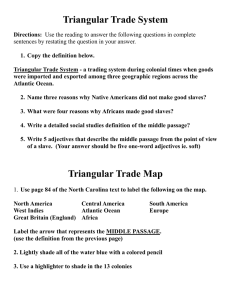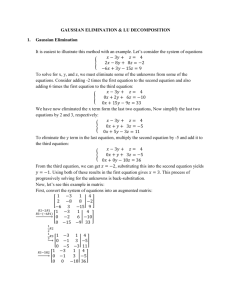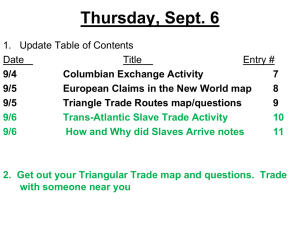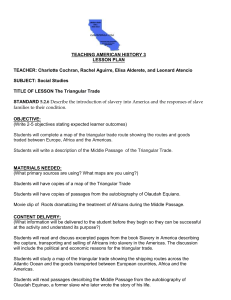LU Decompositions A efficient method for solving the system
advertisement
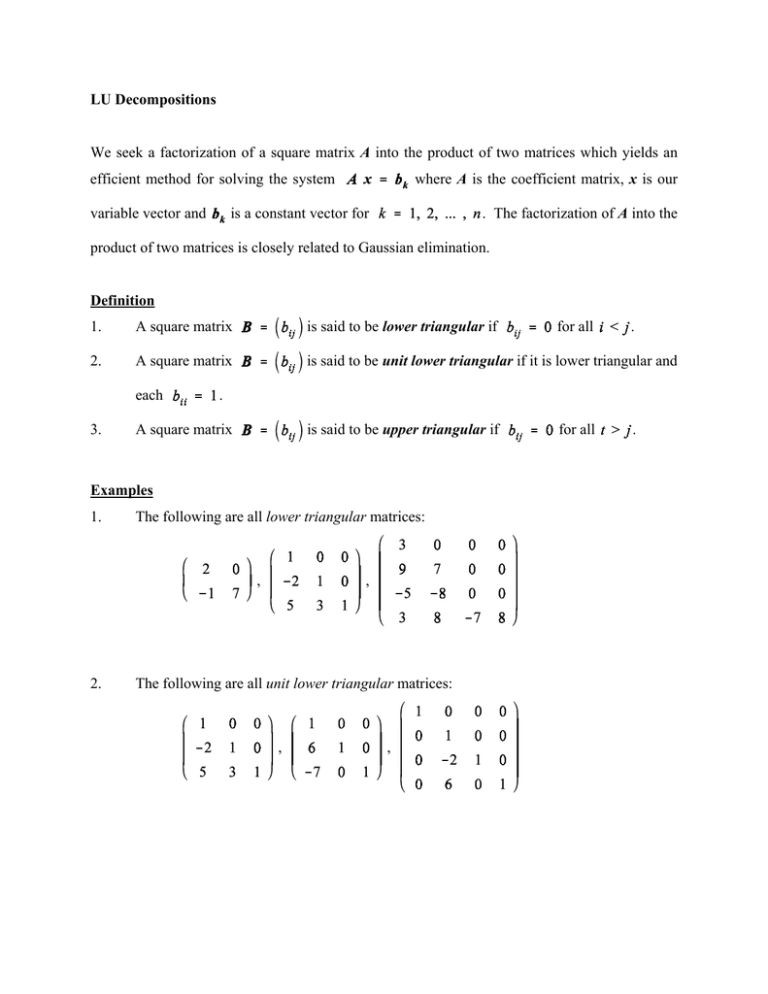
LU Decompositions We seek a factorization of a square matrix A into the product of two matrices which yields an efficient method for solving the system variable vector and where A is the coefficient matrix, x is our is a constant vector for . The factorization of A into the product of two matrices is closely related to Gaussian elimination. Definition 1. A square matrix is said to be lower triangular if 2. A square matrix is said to be unit lower triangular if it is lower triangular and each 3. A square matrix is said to be upper triangular if The following are all lower triangular matrices: , 2. . . Examples 1. for all , The following are all unit lower triangular matrices: , , for all . 3. The following are all upper triangular matrices: , We note that the , identity matrix is only square matrix that is both unit lower triangular and upper triangular. Example Let . For elementary matrices (See solv_lin_equ2.pdf) and , we find that . Now, if , then direct computation yields , and . It follows that and, hence, that where L is unit lower triangular and U is upper triangular. That is, . Observe the key fact that the unit lower triangular matrix L “contains” the essential data of the three elementary matrices , , and . Definition We say that the matrix A has an LU decomposition if where L is unit lower triangular and U is upper triangular. We also call the LU decomposition an LU factorization. Example 1. and so has an LU decomposition. 2. The matrix has more than one LU decomposition. Two such LU factorizations are and . Theorem 1. The product of two lower triangular matrices is a lower triangular matrix. 2. The product of two unit lower triangular matrices is a unit lower triangular matrix. 3. Every unit lower triangular matrix is nonsingular and its inverse is also a unit lower triangular matrix. Proof 2. Suppose M and N are unit lower triangular matrices. Let for all and for each i. Let . We must show that and consider: . Consider 3. Let matrix be an unit lower triangular matrix. Now, define the elementary where . Then one can show that . (We note the order of the products within a given set of parenthesis above doesn’t impact the product but the order of the groups of products does matter. We also note that each group in some sense yields a column of L.) Hence, L is the product of elementary matrices and so it is nonsingular. It is now a relatively easy exercise to show that the inverse is unit lower triangular. (Hint: What is the inverse of ?) Theorem A square matrix A has an LU decomposition iff no row interchanges are required in the Gaussian reduction of A to upper triangular form. If A is nonsingular, the decomposition is unique. We leave the above as an exercise. Example Find the LU decomposition for the matrix . Solution We “build” the unit lower triangular matrix L as we use Gaussian elimination to transform C into an upper triangular matrix U. , , , , , , So, we have that Problem Find the LU decomposition for the following matrices. 1. 2. Key Questions: 1. How does one use the LU decomposition to solve the system 2. Why does one care about this method of solution? Consider the system ? and suppose A has an LU decomposition given by . Then Y Y where Now, first solve the lower triangular system for y using forward substitution and then solve the upper triangular system for x using backward substitution. The solution vector x then solves the original system . Example Solve the system using the LU decompositions where and . Solution From a previous example we know that . So, we first solve the lower triangular system using forward substitution: Here we have that Y Y Y Y Y We now solve the upper triangular system We now have that Y Y Y Hence, Y Y Y Y solves the system . Now for the second question, why does one care about using the LU decomposition method to solve the system where the coefficient matrix A is an by Gaussian elimination requires roughly decompositions requires roughly square matrix? Solving operations and solving operations. So, for a single system there is no compuational savings using the LU decomposition. However, if we must solve the systems is a constant vector for via LU , then it requires roughly via LU decomposition but roughly only where operations to solve operations to solve the remaining for using LU decomposition since we have the unit lower triangular matrix L and the upper triangular matrix U from solving . The table below shows approximately the number of operations required to solve and via two Gaussian eliminations and via two LU decompositions where A is of size . n Gaussian Elimination LU Decompositions 10 700 400 20 5300 3100 30 18000 9900 40 42700 22900 50 83300 44200
